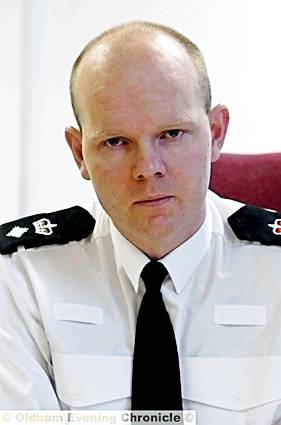Local policing is the key to a better Oldham
Reporter: Richard Hooton
Date published: 27 May 2011
IT’S 10 years since Oldham hit national headlines with three days of rioting that shook the borough. In the final part of our week-long feature, reporter Richard Hooton looks at the criticism of policing and the community and how it has been addressed.
CRIME has plummeted in Oldham since the local police force was restructured following the race riots.
Reports into the causes of the violence criticised the police in 2001 — but the restructuring has delivered success 10 years later.
The Cantle Report into the disturbances specified that the police needed to do more to win the confidence of all Oldham’s communities, especially if the gang and drugs culture was to be tackled.
It said the make-up of the force should reflect the communities it served and there were concerns that police treated all attacks on black and ethnic minority victims as racist.
The Ritchie Report said policing was a contributory factor to the riots and that officers were too slow in responding to incidents. It called for a review of the policing structure, which needed to be one that’s more sensitive to the community it serves.
Chief Supt Tim Forber, who has been in the post for just over a year, said the core policing service in Oldham is now delivered through six dedicated neighbourhood policing teams each led by an inspector with responsibility for a defined geographical area.
“By structuring ourselves in this way we can meet the day-to-day needs of the community in a more responsive way,” he said. “At an operational level these policing teams work at the heart of the six District Partnerships, which enables the delivery of real solutions to local community safety challenges throughout the borough.”
Chief Supt Forber says the partnership driven approach to community safety has led to overall crime falling by 41 per cent, from 30,964 crimes in 2002/03 to 18,035 in 2010/11.
Over the past four years serious violent crime throughout the borough has fallen by 59 per cent with particular improvements around Oldham town centre.
Addressing Ritchie’s criticism, police in Oldham now have some of the best response times in Greater Manchester, attending 97 per cent of emergency calls within 15 minutes over the past 12 months and 90 per cent of priority calls within an hour.
Hate crime, a key factor in the tensions that sparked the riots, has reduced from 1,300 in 2001 to 360 last year.
The Ritchie Report said there were insufficient social and leisure facilities for the young. But the multi-agency Go Oldham initiative has been successful in co-ordinating and publicising activities for young people across the borough with anti-social behaviour falling by 29 per cent over the past two years.
And the proportion of police officers and staff from black and minority ethnic groups working within the Oldham Division has more than doubled since 2001 — from 2.99 per cent to 6.84 per cent.
“Perceptions of policing have also improved,” added Chief Supt Forber.
“Sixty three per cent of Oldham residents surveyed agreed that the police and the local authority are dealing with anti-social behaviour and the crime issues that matter locally and 80 per cent of people surveyed believe that the police are doing an excellent or good job.”
Most Viewed News Stories
- 1Oldham man caged after 150 wraps of crack cocaine were found during house search
- 2Police probe follows Chadderton pepper-spraying incident
- 3Dynamic rescue team duo pledge to raise funds for brave Finn
- 4‘Completely inappropriate’ caravan park plans rejected
- 5Councillor challenges village post box issues





